Karachi
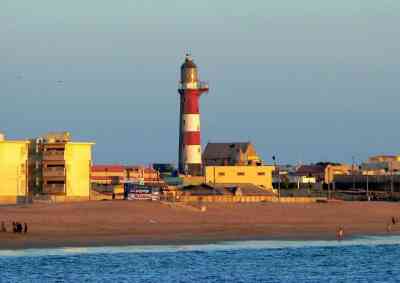
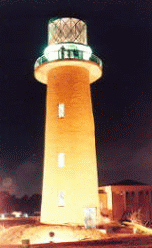
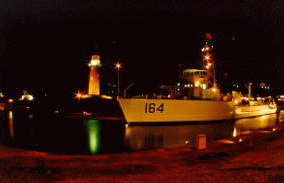




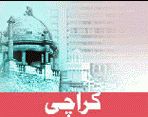 Located on the mouth of the Arabia Sea, Karachi is the largest city of Pakistan and one of the important sea port. A modern
metropolis with a population of over 13 million, Karachi when compared to Lahore or even Multan is a much younger city.
There was nothing much at Karachi until the Mirs of Talpur seized it from the Khan of Kalat in 1795 and constructed a mud fort at Manora.
Originally what now constitutes Karachi was a group of small villages
including Kalachi-jo-Kun or just Kolachi and the fort of Manora. Any history
of Karachi prior to the 19th century is sketchy. Karchi is also said to be
called Krokola from which one of Alexander the Great's admirals sailed at
the end of his conquests was the same as Karachi. In 1729, Kolachi-jo-Goth
became a trading post when it was selected as a port for trade with Muscat
and Bahrain. In the following years a fort was built and cannons brought in
from Muscat were mounted on it. The fort had two doorways, one facing the
sea called the Khara Darwaza or Brackish Gate and one facing the River Lyari
called the Meetha Darwaza or Sweet Gate. Currently, the site of those gates
corresponds to the location of the neighbourhoods of Kharadar and Meetha-dar.
In 1795 the city passed from the Khan of Kalat to the Talpur rulers of Sindh.
The town then swelled and by 18181, had a population of some 13,000.
Not much happened thereafter until 1st February 1839, when a British ship - the Wellesley - anchored off Manora. Two days later the little fort surrendered without a shot being fired on either side.
Three years later, it was annexed into British India as a district. The fickle finger of fate had suddenly shoved the sleepy back-water towards becoming a megalopolis, a world city.
Located on the mouth of the Arabia Sea, Karachi is the largest city of Pakistan and one of the important sea port. A modern
metropolis with a population of over 13 million, Karachi when compared to Lahore or even Multan is a much younger city.
There was nothing much at Karachi until the Mirs of Talpur seized it from the Khan of Kalat in 1795 and constructed a mud fort at Manora.
Originally what now constitutes Karachi was a group of small villages
including Kalachi-jo-Kun or just Kolachi and the fort of Manora. Any history
of Karachi prior to the 19th century is sketchy. Karchi is also said to be
called Krokola from which one of Alexander the Great's admirals sailed at
the end of his conquests was the same as Karachi. In 1729, Kolachi-jo-Goth
became a trading post when it was selected as a port for trade with Muscat
and Bahrain. In the following years a fort was built and cannons brought in
from Muscat were mounted on it. The fort had two doorways, one facing the
sea called the Khara Darwaza or Brackish Gate and one facing the River Lyari
called the Meetha Darwaza or Sweet Gate. Currently, the site of those gates
corresponds to the location of the neighbourhoods of Kharadar and Meetha-dar.
In 1795 the city passed from the Khan of Kalat to the Talpur rulers of Sindh.
The town then swelled and by 18181, had a population of some 13,000.
Not much happened thereafter until 1st February 1839, when a British ship - the Wellesley - anchored off Manora. Two days later the little fort surrendered without a shot being fired on either side.
Three years later, it was annexed into British India as a district. The fickle finger of fate had suddenly shoved the sleepy back-water towards becoming a megalopolis, a world city.
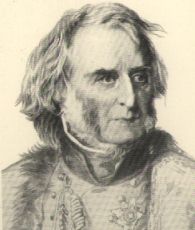 Its development during Sir Charles Napier's era has been significant, who once said "Would that I could come again to see you in your grandeur!". Napier's quote proved almost prophetic and today Karachi has all what a thriving seaport anywhere in the world should have - wide sunny beaches and yachting, deep-sea fishing, golf and horse racing all-year round.
Karachi was not what many see it today. At the time of independence though trams were used as means of transportation in some selected sections of the city, it had mostly camel driven carts snailing around the city.
Some Victorian style buildings could be seen in the city centre. In fact Karachi as a city lacked a rich cultural past or the absence of historical buildings. Some of the old
Victorian buildings that still stand to their glory include the famous Frere Hall.
Its development during Sir Charles Napier's era has been significant, who once said "Would that I could come again to see you in your grandeur!". Napier's quote proved almost prophetic and today Karachi has all what a thriving seaport anywhere in the world should have - wide sunny beaches and yachting, deep-sea fishing, golf and horse racing all-year round.
Karachi was not what many see it today. At the time of independence though trams were used as means of transportation in some selected sections of the city, it had mostly camel driven carts snailing around the city.
Some Victorian style buildings could be seen in the city centre. In fact Karachi as a city lacked a rich cultural past or the absence of historical buildings. Some of the old
Victorian buildings that still stand to their glory include the famous Frere Hall.

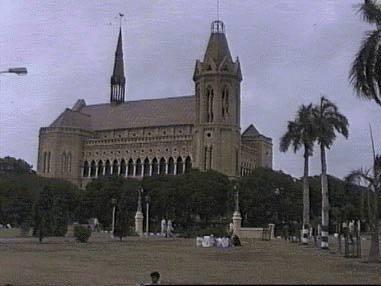
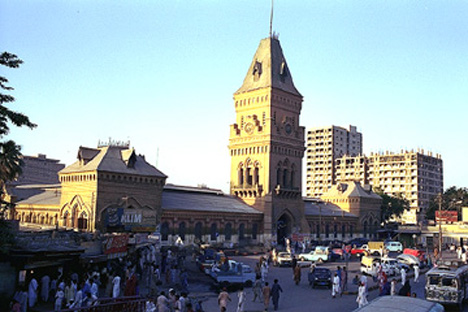
Camel driven cart in 1947 (left), Frere Hall (after Sir Bartle Frere) (centre - constructed 1865), Empress Market (right - constructed 1889)
 Karachi assumes a special significance in history of Pakistan since
Jinnah, Muhammad Ali, commonly known in Pakistan as
Quaid -e-Azam (the Great Leader) and the its very founder was born in Karachi on 25 December 1876 in a dwelling which is knows as "Khara Dar" and is part of old Karachi (then "The Karachi").
Karachi assumes a special significance in history of Pakistan since
Jinnah, Muhammad Ali, commonly known in Pakistan as
Quaid -e-Azam (the Great Leader) and the its very founder was born in Karachi on 25 December 1876 in a dwelling which is knows as "Khara Dar" and is part of old Karachi (then "The Karachi").
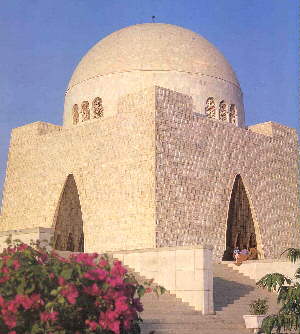 Jinnah studied in the famous school "Sindh Madrassa -tul-Islam" before leaving for the UK for higher education. It is the same city where he was sworn inas he first Governor General of Pakistan (since on
independence in 1947, Karachi was made the capital of Pakistan till it was shifted to Islamabad). And it is the same city where he died on 11 September 1947 and buried. Besides Jinnah, her sister Fatima
Jinnah, who was his right hand all along Jinnah's political career and struggle for Pakistan and Liaquat Ali Khan, the first prime minister of
Pakistan, are also buried in the same compound where Jinnah is buried.
Jinnah studied in the famous school "Sindh Madrassa -tul-Islam" before leaving for the UK for higher education. It is the same city where he was sworn inas he first Governor General of Pakistan (since on
independence in 1947, Karachi was made the capital of Pakistan till it was shifted to Islamabad). And it is the same city where he died on 11 September 1947 and buried. Besides Jinnah, her sister Fatima
Jinnah, who was his right hand all along Jinnah's political career and struggle for Pakistan and Liaquat Ali Khan, the first prime minister of
Pakistan, are also buried in the same compound where Jinnah is buried.
 From camel/donkey carts and cycle rickshaws
and trams, Karachi has come a long way. Today mini buses and metro buses have replaced carts and trams. While a majority of people wait for the buses after a hard day's work, gleaming new
air-conditioned cars whiz by on broad and busy roads. While the Karachi Stock Exchange index soars to new limits, being one of the fast in Asia, a majority of middle class people, who Karachi feeds of his established industrial base, look on. Since independence in 1947, Karachi has swelled into a very big city with modern buildings replacing the old ones, though some old hearts weep with nostalgic memories when any old building goes down.
From camel/donkey carts and cycle rickshaws
and trams, Karachi has come a long way. Today mini buses and metro buses have replaced carts and trams. While a majority of people wait for the buses after a hard day's work, gleaming new
air-conditioned cars whiz by on broad and busy roads. While the Karachi Stock Exchange index soars to new limits, being one of the fast in Asia, a majority of middle class people, who Karachi feeds of his established industrial base, look on. Since independence in 1947, Karachi has swelled into a very big city with modern buildings replacing the old ones, though some old hearts weep with nostalgic memories when any old building goes down.
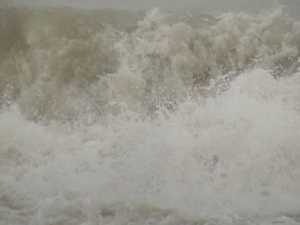

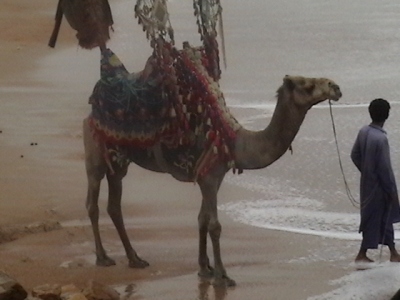
Karachi has a number of beaches, sun bathed with blue water kissing and taking away the warmth from the sun baked sand. French Beach is the finest beach in Karachi. The water is clean and the air is crisp. There are gorgeous rocks embedded in the ocean. The waves splashing against them is quite a lovely sight. But the Clifton Beach is the most visited as it is the only beach that is in the immediate city, close that is. All the other ones are farther away. Hawks Bay is yet another wonderfully sunny and sandy beach. The water is clean and if you need a tan, it is the beach to go to. The huts allow total privacy and the view is magnificent. If someone is interested in turtles then Sand Spit is the beach to go to. Paradise Point is the last beach on Sind's limits. It is a fairly rocky, allowing no swimming.
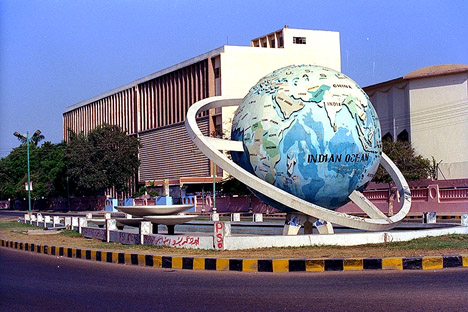 |
Today Karachi is bursting with skyscrapers, modern 5 star hotels and restaurants and many public parks and theatres. Karachi is host to the annual Kara Film festival. Although this festival is very new it has gained an eminent position in international circles. Karachi is the financial capital of Pakistan and also home to the largest stock exchange of Pakistan: the Karachi Stock Exchange. Most Pakistani banks have their headquarters in Karachi. The headquarters of nearly all the multi-national companies based in Pakistan are in Karachi. Karachi also has a huge industrial base. The Karachi Steel Mills, the pride of the nation, is located near Port Bin Qasim and provides the much needed steel for the development of the country. There are large industrial estates on most of the fringes of the main city. The main industries are textiles, pharmaceuticals, steel, and automobiles, besides many cottage industries . Karachi is also developing into a software hub of Pakistan. Most of the shipping and trading is done through the Karachi Port, the only large port in Pakistan, augmented by Port bin Qasim, located some 35 kilometres west of Karachi Port. However, Gwader Port is fast coming up some 500 kilometres west of Karachi, which has already been connected by the Makran Coastal Highway. The Quaid-e-Azam International Airport is also the largest airport in Pakistan and the hub of most local airlines. For years it served as the gateway to Asia with all major airlines operating from the Airport. The airport serves a potential to act as the major logistic hub for the sub-continent. Karachi is a true representation of Pakistan as people from all races and regions of Pakistan abound here which also is the chief reason that its restaurants provide a wide choice and range of Pakistani cuisines. One can find endless variety of Pakistani handicrafts like rugs / carpets of rare design and beauty and ornaments and clothes. In fact one can call it a ethnic and linguistic pot pouri of Pakistan. |
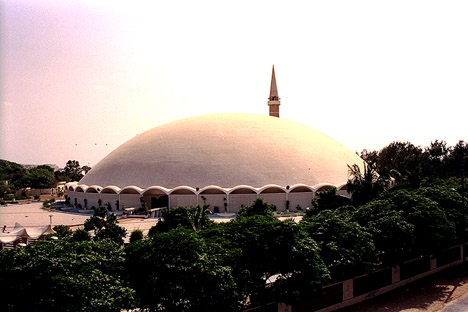 |
|
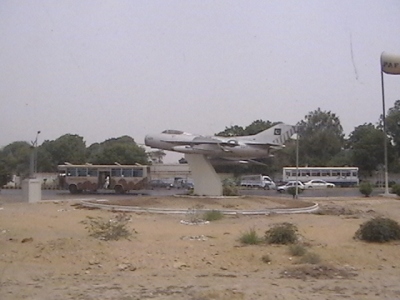 |
Related Links: | Pictures of Old Karachi | Jinnah's Tomb | PAF Museum |
|
| HOME PAGE | MORE CITIES | KARACHI PICTORIAL | |
This page was created on 1 January 2005 /
![]() 6 December 2006
6 December 2006